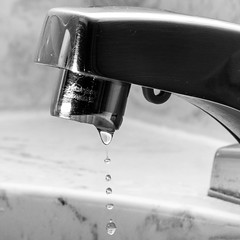![]()
![]()
![]()
Use LEFT and RIGHT arrow keys to navigate between flashcards;
Use UP and DOWN arrow keys to flip the card;
H to show hint;
A reads text to speech;
6 Cards in this Set
- Front
- Back
|
INTRO Water itself has been around pretty much as long as the earth has! Water keeps going around and around and around and around and (well, you get the idea) in what we call the "Water Cycle". This cycle is made up of a few main parts: 1. Evaporation 2. Condensation 3. Precipitation 4. Collection |
➔ Evaporation: is when the sunheats up water in rivers or lakes or the ocean and turns it into vapor or steam. The water vapor or steam leaves the river, lake or ocean and goes into the air. Do plants sweat? Well, sort of.... People perspire (sweat) and plants transpire. Transpiration is the process by which plants lose water out of their leaves. Transpiration gives evaporation a bit of a hand in getting the water vapor back up into the air. |
|
|
➔ Condensation: Water vapor in the air gets cold and changes back into liquid, forming clouds. This is called condensation. You can see the same sort of thing at home... Pour a glass of cold water on a hot day and watch what happens. Water forms on the outside of the glass. That water didn't somehow leak through the glass! It actually came from the air. Water vapor in the warm air, turns back into liquid when it touches the cold glass. |
➔ Precipitation: occurs when so much water has condensed that the air cannot hold it anymore. The clouds get heavy and water falls back to the earth in the form of rain, hail, sleet or snow. |
|
|
➔ Collection: When water falls back to earth as precipitation, it may fall back in the oceans, lakes or rivers or it may end up on land. When it ends up on land, it will either soak into the earth and become part of the “ground water” that plants and animals use to drink or it may run over the soil and collect in the oceans, lakes or rivers where the cycle starts all over again. |
IMPORTANCE OF WATER CYCLE - It occurs because water can change from one state to another. - It makes sure that there's a never-ending supply of water for the survival of all living things on Earth. |
|
|
BE HYDRO-LOGICAL FACT: Morewater is used in the bathroom than any other place in the home. ACTION: Turn off thewater when you brush your teeth and shave. Install low-flow toilets, showerheads and faucet aerators and you’ll save thousands of gallons/liters of watera year. It’s a savings that should reduce your water bill. |

|
|
|
BE HYDRO-LOGICAL FACT: Your city government and state officials regularly make decisions that affect the quality of your drinking water resources. ACTION: As the population grows and housing and industrial interest expand, attend local planning and zoning meetings and ask what’s being done to protect water resources from contamination. Let elected officials know that you expect them to use their hydro-logic to protect the water. |

|
|
|
BE HYDRO-LOGICAL FACT: A dripping faucet can waste up to 2,000 gallons/7,600 liters of water a year. A leaky toilet can waste as much as 200 gallons/260 liters of water a day. ACTION: Check your plumbing and repair any leaks as soon as possible. |

|

